LIGHTSCAPES Episode 1: Grand Ise Shrine trailer from Peter H. Chang on Vimeo.
I was introduced to Akira Hasegawa and his art during the filming of “Children of Enlightenment”, my documentary about Japanese youth counterculture. The renowned director of over 4,000 commercials and the pioneer of the Digital Kakejiku (D-K) art form, Akira is a true renaissance man. He is deeply philosophical and even brews spectacular sake. He is such a fascinating subject that I immediately decided to devote an entirely separate documentary to Akira in order to fully capture the essence of the man and his work. Based on the strength of my photography and film projects, he entrusted me to tell his story and bring his art to American audiences. Collaborating closely with Christopher Frey at Cross Media International, this led to the development of a new television series featuring Akira’s art.
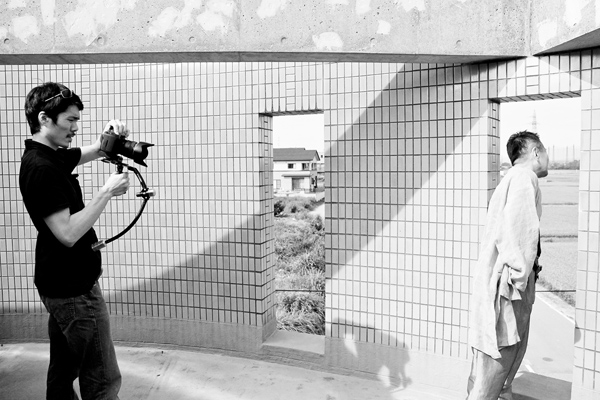
The first step was deciding how to film it. Viewing one of my favorite films, “Baraka”, on Blu-ray was a revelation. It was shot in 70mm film, and I had seen it several times in 70mm, but I was startled at the image quality at 1080p. It turns out that they did an 8K scan from the original negative! It makes a big difference when you downconvert to HD from 4K or 8K, not to mention future-proofing your footage to some extent – 4K displays already exist and are the wave of the future. The picture is perceptibly sharper and richer. While our finishing format would be 1080i for broadcast and 1080p for Blu-ray, I wanted to start with the largest, highest resolution format possible.
Obviously, we did not have the budget for 70mm film. For the timelapse sequences, we needed a camera that could capture Akira’s art at night. We quickly settled on the Canon 5DmkII due to its huge full-frame sensor, low-light capabilities, and its overall image quality. We would capture the timelapse sequences at 5.6K RAW – more than ten times the resolution of standard 1920×1080 HD and near IMAX quality. For the real-time cinematography, we decided to shoot with the Red One at 4K RAW. We would use the Birger Canon EF mount and fast Canon L lenses to allow us to maintain a consistent look. I brought DP Paul Leeming onboard to handle the Red One, while I tackled the timelapse photography.
Our first shoot was at the Grand Ise Shrine, Japan’s most revered and sacred site. Akira’s D-K Live art installation took place at the entrance to the shrine – the historic Uji Bridge – as part of the re-opening and re-dedication ceremonies of the traditional wooden structure, which is rebuilt every 20 years. The event coincided with “Bunka no hi”, the Japanese national holiday celebrating culture and the arts, and was watched by a crowd of 250,000 on the banks of the Isuzu River.
It was a daunting shoot that lasted a day and a half. Akira’s D-K art had never before been captured in timelapse, let alone with this kind of technology. The D-K imagery changes once a minute, synchronized to the human heartbeat. It changes so slowly that if you are looking at it in real time, you may not notice it changing at all. It was critical to figure out proper exposures and intervals prior to the D-K Live installation. The only problem – Akira does not do test runs. We finally persuaded him to allow us a quick dry run the evening before, despite a light rain.
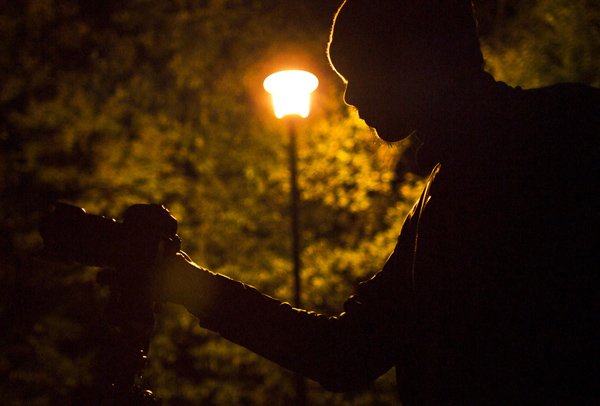
After a few scant hours of sleep, we were back out at the shrine at 4:30am capturing the sunrise. It was an honor to be given access to film at the shrine, so we wanted to respect the sanctity of the temple and environment. We had a very small crew, so we were able to operate in a very unobtrusive manner while remaining agile and mobile. Since we had a lot of ground to cover in a short time, it was critical that we be able to move quickly. Timelapse intervals ranged from 1 to 4 seconds.
One thing both Akira and I wanted to make sure to capture was the transition from day to night – as the sun sets, Akira’s D-K shines and rises. Having had no opportunity to test this, it was going to be a bit of a nail-biting shot in the dark. I would only have one shot at this. Rather than going with aperture priority and then removing the flicker in post, I decided to use multiple cameras shooting in manual, starting the shots one stop over, halting one stop under, then repeating. Length of exposures ranged from 1/3 to 1.3 seconds at 3 second intervals.
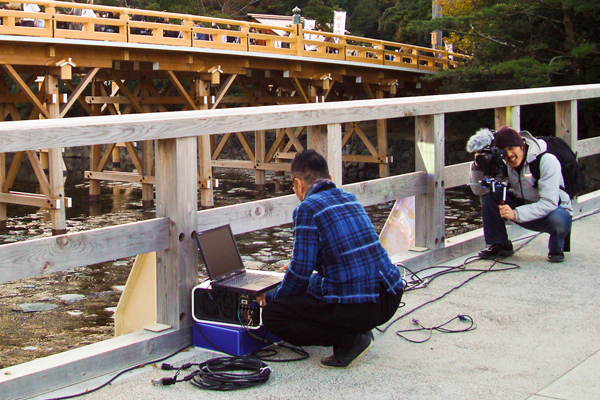
During the D-K Live exhibition, I set up three cameras to shoot simultaneously at 3-5 second intervals. I found myself sprinting back and forth between the cameras, as two of them were placed on opposing river banks. The CF cards filled up quickly shooting RAW timelapse. Luckily, I had a Nexto DI eXtreme on hand, which allowed me to offload and back-up cards immediately and reuse them. It got a bit frantic at times. Next time I will bring more cards!
The shoot culminated with the spellbinding sight of thousands of people carrying candlelit red lanterns across the bridge. I wish we’d had more cameras rolling! It was tough to maintain a steady timelapse shot with the crowds of people swarming past since the tripod legs would constantly get bumped and the wooden bridge vibrated with all the pedestrians. For this scene, I used a 1/2s shutter to allow for a bit of motion blur and 1 second intervals for the timelapse. I attempted several pans, but due to interfering foot traffic they were unsuccessful.
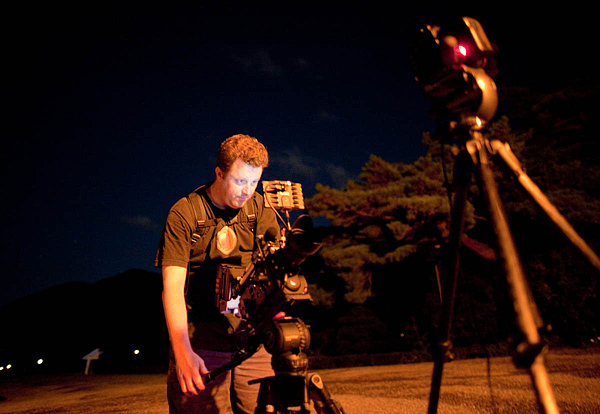
Coupled with fast Canon L lenses (17, 24, 35, 85, 135, 70-200), the high ISO capabilities of the 5D Mark II excelled at capturing Akira’s kaleidoscopic D-K display with crystal clarity and minimal noise. One of our biggest challenges was capturing the low light real-time footage at night on the Red One. With the D-K art projection, candlelit lanterns, and a bit of moonlight as the only light sources, it was difficult to hold enough light to give the images clarity and color depth. However, the dynamic range of the Red sensor and shooting in 4K allowed us to downconvert the image to HD in post, resulting in less noise and a sharper image. While the Ise Shrine episode was shot on Red’s first generation camera sensor, subsequent episodes will be shot on the new Mysterium-X sensor, capable of greater dynamic range and much improved low light performance.
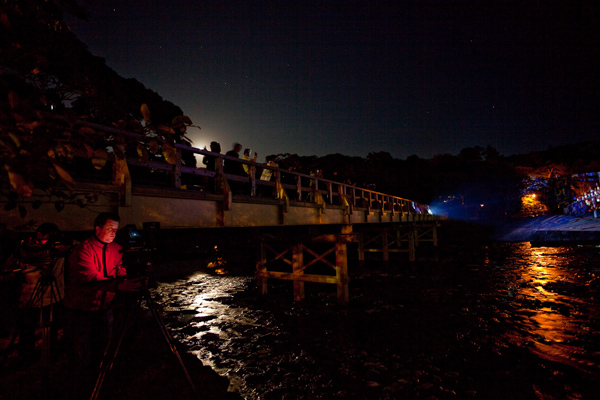
In addition to the timelapse photography, I also captured 1080p video with the 5D Mark II throughout the shoot for the upcoming standalone Akira Hasegawa documentary. Altogether, for this first episode, we captured nearly 9 hours of footage on the Red, and over 15,000 still timelapse frames on the Canon 5D Mark II.
To post-process the timelapse stills, I used Adobe Lightroom 3 beta. This was a somewhat slow and cumbersome process – it took a week to edit and then export 15,000 RAW files. I then brought those sequences into Adobe Premiere Pro CS4 alongside the R3D files, which Premiere handles natively. As luck would have it, Paul was on the beta team for Adobe Premiere Pro CS5 so we were able to use CS5 for color correction – it works much better with Red footage than CS4 because it incoporates the RedSpace color science that we shot with.
With the premiere episode of Lightscapes, I am thrilled to help bring both the Ise Shrine and the art of Akira Hasegawa to American audiences.
LIGHTSCAPES premieres Monday, June 21 on Discovery HD Theater at 7:30 AM ET / PT.
LIGHTSCAPES is produced for Discovery HD Theater by Cinefugue Productions and Cross Media International. http://lightscapes.tv







